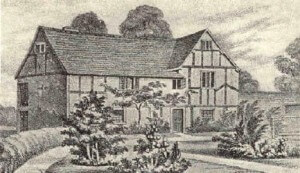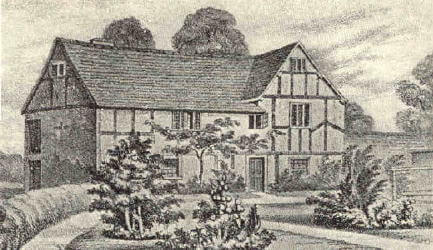This article was written by Wendy Tibbitts for the Amersham Society/Amersham Museum newsletter in 2013 and is reproduced here with permission.
Thomas Ellwood – friend of Friends

Some 300 years ago, on 1st May 1713, Thomas Ellwood died at his house at Hunger Hill, Coleshill. He was 73. He had no children and his name might have been erased from history if not for his very readable autobiography which was published the year after his death. The History of the Life of Thomas Ellwood Written in His Own Hand had its first reprint in the year of publication and has been in continuous print ever since. It is a first-hand account of his relationship with John Milton, William Penn and Isaac Penington and the struggles of the early Quakers, but for us it is also a slice of local history which gives us an insight into the history of some of the local buildings and life in the seventeenth century.
Ellwood was born the second son of Walter and Elizabeth Ellwood of Crowell in Oxfordshire. His father was a small landowner and magistrate. During the civil war the family lived in London and it was there that they became acquainted with the widowed Lady Springett and her daughter, Guli. When it was safe for the Puritan family to return to Crowell, Thomas and his elder brother were sent to Thame Grammar School. Thomas was bright and studious and eager to learn so he was disappointed that his father could only afford to send his elder brother to University.
By the time Thomas was 20 his brother and mother had died, and Thomas whilst continuing his self-studies would accompany his father on his magisterial rounds. This exposure to the law and the wording of legal documents were to be useful later in life.
Early interest
One day in 1659 Thomas and his Father went to Chalfont St Peter to pay a courtesy call on Lady Springett who had recently married Isaac Penington and moved into The Grange. (The original Grange no longer exists, but a later building was used as a convent and school from 1929.) Both Ellwoods were surprised to find the family had become Quakers and their lifestyle was very different from the ‘free, debonair and courtly behaviour’ they had previously shown. Neither Father nor son had heard of the Quakers or knew anything about their beliefs, but Thomas was intrigued. He began visiting the Grange more frequently and listening to the preachers who visited. His eventual acceptance into the Society of Friends brought him into conflict with his Father and the law. His Father withdrew his financial support, his horse, and attempted to keep him a prisoner at Crowell. In defiance of his father Thomas walked to Chalfont St Peter and Quaker meetings in other places. Thomas continued to study in his spare time and eventually through an acquaintance of Isaac Penington he became a pupil of John Milton in London. The lessons were interrupted by Thomas’s poor health and by being imprisoned for attending Quaker meetings.
In 1662 the Peningtons asked Thomas if he would be tutor to their growing family of four children. Thomas moved into the Grange and for the next seven years devoted himself to the service of the family. When he wasn’t teaching he had the use of his host’s library for his private studies, and the friendship of Gulielma Springett, Mary Penington’s daughter from her first marriage. There is no doubt that he admired her and might have been in love with her, but she was ‘openly and secretly sought and solicited by many, and some of them almost of every Rank and Condition.’ Ellwood knew that she would not marry until ‘he at length came for whom she was reserved’ so he ‘enjoyed as much of her favour and kindness, in a virtuous and firm friendship, as was fit for her to shew or for me to seek’. They remained close friends for the rest of their lives.
Imprisonment in Aylesbury.
On 1 July 1665 Isaac Penington and Thomas attended the funeral of Edward Perot in Amersham. The mourners carried the coffin along the street intending to bury it at the Quaker burial ground in Whielden Street where the meeting house now stands, but waiting in the Griffin Hotel was Ambrose Benett, a JP, who with a number of Constables arrested the funeral party and took them to Aylesbury Goal, where they were kept for a month. While Thomas was in prison, John Milton had moved into ‘a pretty little box’ that Thomas had rented for him and his family. Milton had removed himself from London to escape the ‘pestilence’ raging there. Thomas had planned to be at the cottage in Chalfont St Giles when the family arrived, but was delayed by his imprisonment. When he did visit, Milton gave him a draft of Paradise Lost to read which Milton published two years later, and Ellwood famously asked, ‘but what hast thou to say of paradise found?’ This prompted Milton to write Paradise regained.
A month after their return from prison Isaac Penington was again arrested and spent another nine months in Aylesbury Goal. While Isaac was in prison his family were forced to leave the Grange. The estate had been a wedding present from Isaac’s father, Alderman Sir Isaac Penington, a former Lord Mayor of London. Penington senior, a Puritan, had been present at the trial of Charles I, and with the restoration of Charles II his estates were sequestered as a punishment. Mary Penington, Guli, four other children, including a new born baby, and Thomas were now homeless. The family were broken up. Guli and her maid went to stay with a friend in Bristol. Mary Penington, Thomas, and the younger children went to Aylesbury to be near to Isaac, but Thomas couldn’t tolerate the poor town air and took lodgings in Chalfont. Eventually Mary Penington rented a farm house called Bottrells, in Bottrell’s Lane, Chalfont St Giles, whilst Thomas was on a trip to Bristol to fetch Guli. Soon after this Thomas, Guli, and some other Friends walked to Hedgerley to attend a Meeting and Ambrose Benett once again broke up the meeting and arrested Thomas. He spent twelve weeks in Aylesbury Goal. On return to Bottrells Ellwood decided the accommodation was too ‘inconvenient’ for the family and rented Berrie House [Bury Farm] in Amersham. They moved there on 29September 1666. Four weeks earlier the Great Fire of London had raged for four days and it is intriguing to wonder if, from their elevated position, they witnessed the glow in the eastern sky from this conflagration.
Life at Bury Farm
After staying only six months at Bottrells they were to remain at Bury Farm – still at the bottom of Gore Hill, Amersham – for seven years. A year after they moved in the youngest child, Edward, was born. Edward was to be the only one of the family who permanently emigrated to Pennsylvania. Bury Farm was often visited by leading Quakers from around the country including George Fox and William Penn. During the last four years of their stay, Mary Penington was renovating and modifying a dilapidated farmhouse called Woodside which was to become the family’s final home. Thomas was now assuming more responsibility for the family. He was also earning increasing respect from other Quakers and was attending Quaker meetings in many counties.
In 1669 he proposed marriage to Mary Ellis a lady some years older than him who lived at Coleshill. After a two week rent-collecting trip with Guli to Kent, Mary Ellis accepted his proposal, and he writes proudly that he ‘did not use those vulgar ways of courtship by making frequent and rich presents’. Thomas and Mary were married on 28 October 1669. His father had promised him an endowment on his marriage, but when Walter Ellwood learned that they had not been married in church he withdrew his offer.
Thomas moved into Hunger Hill, Coleshill, (now called Ongar Hill) where he lived until his death forty years later. He continued to assist the Peningtons and to accompany Guli on her trips to Kent and Sussex to collect rents. He was very active in the Society of Friends writing pamphlets and books on the gospels. He held monthly meetings of the Society of Friends at his house which he meticulously minuted. On 7 February 1672 he minutes the intention of marriage between William Penn of Walthamstow and Gulielma Maria Springett. They were married in Chorleywood later that year.
Pennsylvania Land
After William Penn became proprietor of Pennsylvania in 1682 Penn drew up a map of the available land and invited Friends to purchase plots off-plan. Many of the first purchasers were from South Buckinghamshire. The Peningtons and Thomas either bought or were given large tracts in Pennsylvania which entitled them to a plot for a town house in Philadelphia. Thomas never went to America, but in his will he left his lands to the grandson of Isaac and Mary Penington who had been born in America. This bequest helped to found a Penington dynasty which made a contribution to the shaping of America.
Thomas was often asked to use his knowledge of the law to draw up legal documents for Friends and negotiate deals on their behalf. After the Act of Declaration of Indulgence of 1687 when non-conformists were given freedom of worship, Thomas was instrumental in helping to purchase a plot of land adjacent to the Quaker burial ground at Jordans on which to build a meeting house. In later years he published extensive works on the Old and New Testaments and compiled the Life of George Fox. His wife predeceased him by five years and when he died of a stroke in 1713 his funeral and burial at Jordans was attended by a ‘very large number’ of Friends from ‘London and other parts’.
Thomas’s house at Hunger Hill no longer exists although there is a later building on the land. In his will he left individual bequests of furniture and possessions to his wife’s sister and other relatives are left sums of money. Gulielma and all the Peningtons predeceased Thomas apart from Isaac and Mary’s daughter, Mary Penington. Thomas leaves her, her husband, Daniel Wharley, and their children sums of money. He also left money to buy apprenticeships for the children of poor Quakers. He appointed his servant Dorothy White to be his executor and leaves her the residue of his possessions and property. A document at the Centre for Buckinghamshire Studies tells us the sequel. Before Dorothy White could administer the estate she married Abraham Dee of Henley-upon-Thames and then shortly afterwards she died. Abraham Dee appears then to have been given probate of both Thomas Ellwood’s and Dorothy White’s estate. We can only surmise that the house was left uninhabited and eventually fell into disrepair.
In a testimony written by Joseph Wyatt, soon after Thomas’s death, Thomas is described as ‘a man of a comely aspect, of a free and generous disposition, of a courteous and affable temper, and pleasant conversation; a Gentleman born and bred, neighbour, and kind friend; whose loss is much lamented, and will be much missed at Home and Abroad.” What better epitaph could a man have than the respect and friendship of his contemporaries? He also has our gratitude for contribution he has made to recording the social history of Amersham in the seventeenth century.
sources:
- Ellwood, Thomas, The history of the Life of Thomas Ellwood, (1714)
- Snell, Beatrice Saxon, The Minute Book of the Monthly Meeting of the Society of Friends for the Upperside of Buckinghamshire 1669-1690 (1937)
- Penington, Mary Experiences in the life of Mary Penington (written by herself), (1911)
- Hayward, Arthur L., Jordans: the making of a community, (1969)
See also the Wikipedia entry

